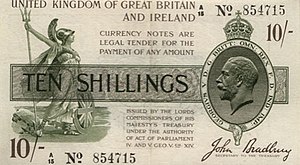HM Treasury
Thomas Cromwell transformed the financial administration of the country, restoring authority to the Exchequer and making the King's Chamber, of central importance under Henry VII, back into a small spending department overseeing the Royal Household.For the majority of the medieval period the office of the Treasury was within the Exchequer (responsible for managing the royal revenue in addition to collecting and issuing money).Eventually the First Lord of the Treasury came, however, to be seen as the natural head of government, and from Robert Walpole on, the holder of the office became known, unofficially, as the Prime Minister.London-based Scottish entrepreneur, William Paterson proposed a "Bank of England" with a "fund for perpetual Interest" (not yet bonds or bills) that was passed by Parliament, supported by Charles Montagu, Chancellor of the Exchequer and Michael Godfrey, another leading City merchant.The public were invited to invest subscriptions totalling £1.2 million forming the initial capital stock onward loaned to the Government in return for a Royal Charter.It is also a commercial bank, dealing in bills and bonds (its own are called Gilts) sold to fund government borrowing, sometimes The Great Trading Franchises such as East India or Royal Africa and South Sea Companies.However, in creating credit-issuing notes not fully backed by cash (gold) in hand, but were partly supported by credit given to the Government or by commerce – rendered itself liable to its depositors wanting all their money returned at once.The Treasury and The Bank faced many crises regarding gold reserve needed for domestic, British Empire, and foreign trade and policy purposes, not all good, practical or merely pragmatic, some undoubtedly nefarious?[citation needed] The Treasury developed new expertise in foreign exchange, currency, credit and price control skills in the management of the post-war economy.The long slump of the 1930s Great Recession necessitated the restructuring of the economy, first by Command Economy necessitated by World War, then following World War II when the National Debt stood at £21 billions by 1945, or 219% ratio to GDP, emphasis on peacetime planning to avoid the slump after WWI when agricultural market prices collapsed.The decision in 1997 to transfer monetary policy setting responsibility to the Bank of England, alongside maintaining responsibility for financial system stability while relegating-out operational banking risk management, oversight and rule-enforcement, to the new Financial Services Authority while the Treasury retained control of fiscal policy led to the creation of the United Kingdom Debt Management Office (DMO) as an executive agency of the Treasury.Government can get involved in industrial strategy and public and some private services in response to strikes, closures, or FDI investment flows.[citation needed] Crises of systemic collapses after excessive confidence inevitably continued through the nineteenth, twentieth and into the twenty-first centuries, some 2 years apart, sometimes ten.When US Treasury Secretary Henry Paulsen learnt of Alistair Darling's approach, only then did he realise he had had no need to apply to Congress for TARP or closedown Lehman Brothers!The funds which the Bank deploys, including note sat issue, specie in circulation, securities, Gold and foreign exchange reserves.However, a revival of interest in Chicago and Austrian Schools of Monetarism, calling for depoliticised central base-rate policy settings, and claiming much would have been better had that been available during the high inflation 1970s.The facility lends to local authorities for capital purposes and the CRND's principal function is to manage the investment portfolios of certain public funds.Exchequers were held twice yearly when the Chief Justice, Lord Chancellor, Treasurer and others sat round the chequer board, to audit and agree accounts of each local sheriff who collected taxes and duties and spent money on behalf of the crown.[14] The previous Permanent Secretary, Sir Tom Scholar, was sacked by Chancellor Kwasi Kwarteng and Prime Minister Liz Truss shortly after they took office.[20] The Green Book includes the historic five case model, which requires consideration of the policy, economic, commercial, financial and management dimensions of a proposed project.At the start of the First World War, the Currency and Bank Notes Act 1914 was passed, giving the Treasury temporary powers to issue banknotes in two denominations, one at £1 and another at 10 shillings, in the UK.They replaced the gold coin in circulation to prevent a run on sterling and to enable purchases of raw materials for armaments production.[21] The Treasury Main Building at 1 Horse Guards Road, often referred to as the Government Offices, Great George Street (GOGGS), was designed by John Brydon following a competition.The works, which were designed by Foster and Partners together with Feilden and Mawson and carried out by Bovis Lend Lease at a cost of £140 million, were completed in 2002.
1 Horse Guards Road, WestminsterGovernment of the United Kingdom1 Horse Guards RoadWestminsterLondonKeir StarmerFirst Lord of the TreasuryRachel ReevesSecond Lord of the TreasuryChancellor of the ExchequerDarren JonesChief Secretary to the TreasuryJames BowlerPermanent Secretary to the TreasuryUK Debt Management OfficePolitics of the United KingdomConstitutionMagna CartaBill of RightsTreaty of UnionActs of UnionParliamentary sovereigntyRule of lawSeparation of powersThe CrownThe MonarchKing Charles IIIHeir apparentWilliam, Prince of WalesRoyal familySuccessionPrerogativeCounsellors of StateRepublicanism in the United KingdomExecutivePrivy CouncilCharles IIIKing-in-CouncilHM GovernmentCabinetStarmer ministryPrime MinisterDeputy Prime MinisterAngela RaynerDepartmentsMinistersAgenciesLegislatureUK ParliamentKing-in-ParliamentHouse of LordsLord SpeakerThe Lord McFall of AlcluithHouse of CommonsSpeakerSir Lindsay HoyleLeader of the OppositionKemi Badenoch59th ParliamentOppositionList of MPsJudiciaryKing-on-the-BenchSupreme CourtPresidentThe Lord ReedDeputy PresidentThe Lord HodgeJustices of the Supreme CourtUnited KingdomEngland and WalesScotlandNorthern IrelandBank of EnglandGovernorAndrew BaileyDeputy governorsMonetary Policy CommitteeCurrenciesBanknotesElectionsreferendumsUK Parliament constituencies2023 Periodic Review of Westminster constituenciesPolitical partiesPolitical Parties, Elections and Referendums Act 2000Dissolution and Calling of Parliament Act 2022Scottish Parliament constituencies and electoral regionsSenedd constituencies and electoral regionsUK general elections1801 co-option1832–331910 (Jan–Feb)1910 (Dec)1974 (Feb)1974 (Oct)DevolutionIntergovernmental relations in the United KingdomLegislative consent motionsPrime Minister and Heads of Devolved Governments CouncilCouncil of the Nations and RegionsEnglandGovernance of EnglandEnglish votes for English lawsGreater London Authority1998 referendumGreater London Authority Act 19992007 ActMayor of LondonSadiq KhanMayoral cabinetLondon AssemblyLondon PlanCombined authoritiesNorthern Ireland Act 19982006 ActFirst MinisterMichelle O'Neilldeputy First MinisterEmma Little-PengellyAssemblyAct of the Northern Ireland AssemblyLaw of Northern IrelandScottish devolution1997 referendumScotland Act 1998